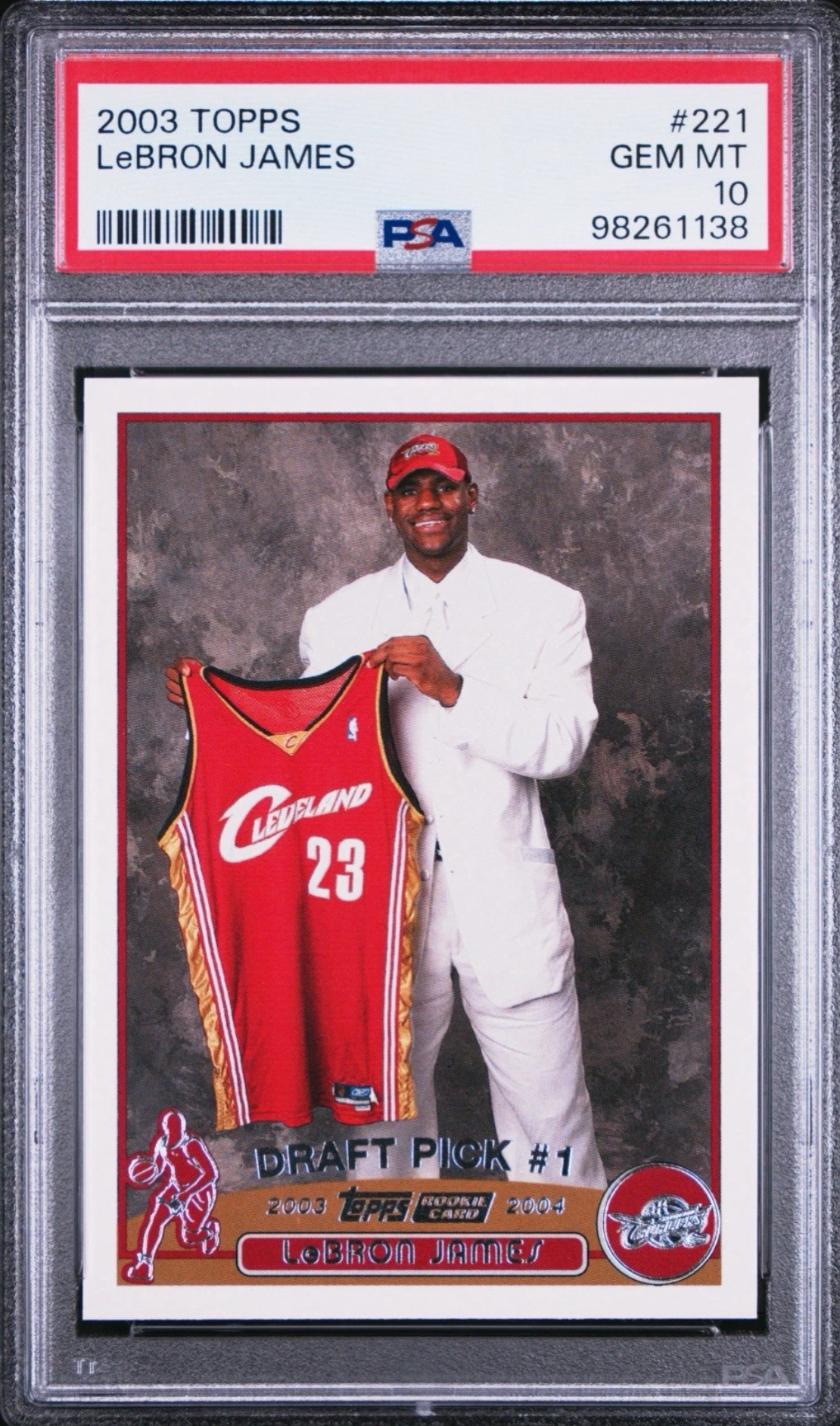In the vibrant and often volatile world of sports card collecting, certain treasures remain firmly planted at the center of attention, perennial favorites that hoist the weight of nostalgia upon their cardstock shoulders. Among these is LeBron James’ 2003 Topps #221 rookie card—a heavy hitter in the sports card universe that continues to captivate collectors and investors alike.
Unlike its flashier, chromatic contemporaries, the classic Topps paper rookie card holds a unique charm that endures the test of time, much like the basketball legend himself. The photo, etched in the minds of even the most casual collectors, evokes memories of an up-and-coming LeBron poised to conquer the NBA and beyond. This singular piece of memorabilia serves as the gateway card for those rekindling their passion for the hobby. It’s the card people ask about as they unwind their old collections and inquire, “Where should I begin?”
Sure, the Topps base might not boast the glitzy allure of its scarcer cousins—those refractors and limited editions that sparkle under the light of a display case. Yet, this card is the cornerstone, the one that initiated a legion of fans into the art of collecting. The balance between supply and demand is finely tuned; there’s enough availability for a competitive chase across various conditions, and the thirst for mint examples keeps the market lively. As of mid-2025, eBay auctions for pristine PSA 10s danced around the two thousand to two thousand one hundred dollar mark, with final bids showing steadfast stability yet slight upward pressure.
Venture back a few months, and you’ll notice a consistent upward tick—a testament to the card’s accumulated prestige and increasing demand, as confirmed by reliable platforms like Card Ladder. A recent late-August sale even hit two thousand five hundred thirty-one dollars, showcasing a steady ascent fueled by substantial trading volumes. The Topps catalog doesn’t end at the base offering; in fact, it fans out in a parade of attractive variants. From the Black Border edition, gracefully limited to 500, to the Gold numbered to 99, and the elusive First Edition, with its understated rarity, these siblings each possess a gravitational pull of their own.
Then, there’s the quirky Topps Collection photo variation, a distant cousin in the family tree providing an alternative yet delightful detour for set enthusiasts. Though it typically resides in the shadow of its more famous sibling, it beckons to those who prefer subtle idiosyncrasies over showy credentials.
Discussing the card wouldn’t be complete without addressing the elephant in the room—grading. The wealth of PSA 10 ratings has bestowed the card with a blue-chip status, a staple rather than an enigma. Yet, the leap from a PSA 9 to a coveted PSA 10 is not negligible in either financial or sentimental terms. For the uninitiated treading lightly, raw versions have been holding their ground within the $250 to $300 range, while PSA 9s typically hover around $400. The delicacy of this balancing act—where centering and surface conditions drastically sway the marketplace—calls for astute observation, quality photos, and seller reliability.
This month, if you’re living by comp charts, the game plan is straightforward: watch the evening eBay auctions for PSA 10s, anticipate bids to hover around two grand, with the occasional heart-thumping battle escalating prices when two collectors refuse to yield. This card, with its mighty circulation and eager eyes glued to it, is a perfect illustration of how price movements unfold in a high-demand landscape.
Endless debates embroil the paper vs. chrome faithful; chrome refractors strut their stuff like proud peacocks, but the paper Topps base wields its history with quiet determination. Slipping neatly into collectors’ binders of yore, it’s the embodiment of transitional times, bridging generations of hobbyists. It sits immovable atop any essential list for LeBron aficionados.
Centuries from now—or maybe just a few years—the card’s quirks will fuel its lore. The design’s white borders unearth any misalignment with laser precision, making centrist accuracy a critical quest. And within the Black Border variant, each microscopic imperfection stands out like a headline act. Therefore, discovering a pristine gem is akin to uncovering a holy grail, an experience that tingles the spine of enthusiasts everywhere.
Whether you’re navigating on a shoestring budget or a limitless treasure chest, pathways abound. A robust PSA 9 invites flagship enjoyment at roughly half the golden prize of a PSA 10, and a sharply centered raw card presents a rewarding grading adventure. The First Edition variant offers rarity without ballooning to Black or Gold premium levels. Collecting isn’t about chasing what the digital masses dictate; it’s about finding resonance between your preference and the tactile expression of the card itself.
The thrill of the hunt is also far from dead; pulling a 2003 Topps LeBron in the wild is every bit a possibility, a testament to mystery and surprise that echo the euphoric heart of collecting itself. If chance smiles upon you during one of our curated Galaxy Rip Packs, you’ll understand why keeping the flame of discovery alive is essential.
What makes reflecting on this card so pleasant in 2025 is its unwavering reputation. Its legacy is cemented, appreciated across checklists and auction listings alike—a steadfast reflection of how deeply it satisfies the varied spectrums of collectors. Stash it, swap it, or rip your way to it; whichever path you choose, its orbit ensures you remain gravitationally tethered to a hobby that, much like the card itself, transcends time.





